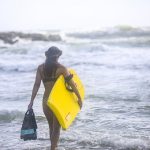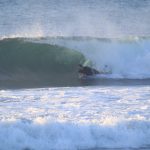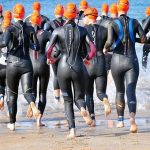If you’re looking to learn how to bodyboard, you’ve come to the right place!
Bodyboarding is a thrilling water sport that can be enjoyed by people of all ages and skill levels.
But getting started can be intimidating, especially if you’re not familiar with the equipment or techniques. In this guide, we’ll provide you with step-by-step instructions on how to learn to bodyboard, from choosing the right board to mastering basic maneuvers.
Whether you’re a beginner or looking to improve your skills, this guide will help you become a confident and competent bodyboarder in no time.
So let’s dive in and catch some waves!
Basic Maneuvers
Bottom Turn
This maneuver is performed by carving the bottom of the wave and then quickly turning up the wave face once you reach the bottom.
If you can’t do a bottom turn properly, you won’t be able to do other maneuvers properly either.
A bottom turn is done by leaning your weight on the left side of your bodyboard, using your left elbow to dig into the waves, and using your right hand to lift the other side of the board. You should lift your inside leg off of the board, and look towards your desired destination.
After you start the turn and are positioned well on the wave, center your body on the bodyboard and release the pressure on your hip and elbow. You can then slide forward slightly to gain speed.
Now you can do the first basic trick!
Drop Knee Riding (AKA DK, Jack Stand, or Hawaiian Stand)
When you are able to ride a bodyboard in the prone position using all the available tricks, you can then try Drop Knee riding. Both stances can be used when riding a bodyboard, and there are just as many tricks that can be performed in each stance.
Drop Knee Riding
The bodyboarder is kneeling on the board with one knee at the back and one foot up at the front. For natural bodyboarders, the left foot is at the front.
This form of bodyboarding, called drop knee DK riding, is similar to surfing in terms of the maneuvers and techniques used. However, it offers a wider range of tricks and is much harder. Just think about standing up on a shortboard without fins.
Jack “the Ripper” Lindholm was the first bodyboarder to ride with his knees dropped and it was during a demonstration at Pipe Master; it was a solid 12 feet + on that day.
How to Drop Knee Ride?
Choose a flat wave to start with for an easy take-off. Once you’re comfortable taking off and getting into a drop knee quickly enough to bottom turn, you can start taking off in hollow waves.
5 Easy Steps:
Described for a regular bodyboarder riding a right-hander, to ride a left-hander, just reverse all the body hand and arm positions. If you are not regular, described for a regular bodyboarder riding a right-hander, just reverse all the body hand and arm positions.
with both of your feet in the footstraps. After you have gotten comfortable withprone riding, you can try getting on your knees with both feet in the footstraps.
The following text is about how to control a bodyboard. With the palm of the left hand, apply pressure to the middle of the left rail. This will help to control the bodyboard while lifting the leg.
Pick up your left foot from the water and place it on the nose of your bodyboard. Simultaneously, use your left hand to keep the bodyboard in balance.
After you have done that, take your right hand and place it on the top right corner of the bodyboard.
. Place your left hand in the (position of 2) and hold it there until you feel completely stable.
Your right foot should be in the water and your fin should be acting as a rudder.
How To Duck Dive
The duck dive is a bodyboarding technique that allows you to get past the breaking waves and get in position for a “clean” unbroken wave.
-To catch a wave, paddle out to it at a good speed and when you get close, move your weight forward and place your hands a little bit below the nose of the board, holding onto the sides tightly.
-Get into a press-up position with your head over the nose of the board and as the wave starts to push the board down, shove your knee into the back of the board to guide it down and stretch your other leg out behind you.
-If you timed it right, the wave should break over you and you can lie flat against the board and look up at the water as it passes over you.
To duck dive, wait for a wave to come and then, when it is about to hit you, move your weight back on your board and angle upwards so that you go under the wave. While you are underwater, keep kicking with your fins so that you do not get pulled back.
The bigger the wave, the earlier you should go under. The main danger when duck diving at shallow reefs is that you will hit the reef if you go too deep. To avoid this, keep your hands flat on the surface of the board or hold onto the sides of the board. Do not put your hands underneath the board.
How To Do A Cut Back
If you find yourself out on the shoulder of the wave after successfully bottom turning, it’s time to initiate a cutback.
For a nice fan of water, you’ll need a reasonable amount of speed, so it’s best to set yourself up with a nice bottom turn. Then, gun it down the line, positioning yourself about midway up the face of the wave.
To turn your board, shift your weight to the rail on the outside of the turn. Lean back near the tail of the board, and lead the turn with your front hand. Arch your back and keep your eyes focused on the direction you’re going.
Now that you’ve shifted all your weight onto the rail, you should produce a big fan of water! The more speed you have and the harder you jam your rail in, the bigger the fan should be.
You’ll use all your speed at this part of your turn, giving the wave a chance to catch up with you.
Step four is to position yourself on the inside rail after you are done with the previous steps and to continue down the wave.
How To Do A Forward Spin (360)
A 360 is a move that is impressive if done correctly in the middle of a wave. They can be part of more complex maneuvers, and are one of the most satisfying basic movements to learn.
You need to be going fast to do a spin, but unlike other moves, you can’t just go full speed. If you’re trying to learn how to spin, going too fast can actually make the move harder. Spins can be done after a cutback or on a sloping part of the wave, which makes it look more impressive.
If you try to do it in a flat section, it’s more difficult and doesn’t look as cool. Once you’ve gotten up to speed, the first step is to release the rail by bottom turning towards the top of the wave and flattening your board out. Lift your legs out of the water too.
To initiate the spin, put your weight on your inside rail while throwing your head and upper body into the rotation. Look over your shoulder to where you want to go. The rotation will be slow at first, but with practice it will become quicker.
Be sure to cross your legs up behind you and arch your back, so your weight is centered in the middle of your board. This will create a central point to spin from, like a spinning top.
Return to the direction you were heading. To stop the spin, drop your flippers back into the water and return to the standard trim position. Then, bottom turn back into the trim. If the maneuver was performed on a steep part of the wave, shift your weight onto the bottom corner of your board.
This will keep you from nose-diving when you come back down the wave. Once mastered, you can perform 360s on different parts of the wave. This will also help you enter competitions and look smooth to your friends.
How To Do A Reverse Spin (360)
A reverse can be done almost anywhere on the wave and can be as easy or difficult as you want it to be. As long as you keep your legs crossed and look in the direction of the maneuver, it should look stylish no matter where it is attempted.
To do a reverse, start with a bottom turn. You don’t need to turn very sharply- just enough to get going. If you turn too sharply, you might go off the back of the wave before you can complete the rotation.
Practice on your shoulder so you have time to complete the move. To initiate the rotation, move slightly forwards on your board and lift your hips and legs out of the water while throwing your head in the direction you want to turn.
Step two: Once you start spinning, try to keep your legs crossed. This not only looks better, but also reduces the chance of a random limb hitting your face. The speed of the spin can be controlled by how high you lift your legs and how long you keep them up.
When you have spun around enough, move back to a normal position, put your legs back onto the ground, and look in the direction you want to go next. reversals are a good way to make the best of a weak section and are more interesting than a cutback or turn.
Basic Combinations
If you are comfortable completing a bodyboard 360, Reverse 360, and cut back, you can start thinking about some simple combos.
You can do a 360 followed by a Reverse 360, or a cut back followed by a Reverse 360 to make some cool combos.
Air
In an aerial, the entire bodyboard extends above the lip.
The air is a maneuver where the entire bodyboard extends above the lip of a wave. Its name suggests that the entire bodyboard goes above the lip of the wave.
Find a wave with a steep section and a lip that will cause the wave to break.
Make sure you’re going fast and aim for the edge of this wave. Don’t try to hit it straight on, choose an angle that will land you in front of the wave after you go over it.
Hit the lip of the wave and then throw your weight so that you’re moving forward.
After landing, re-engage your rail for the next move.
The El Rollo
The rollover is a cornerstone trick in bodyboarding. It consists of air but just after being pushed by the lip, the bodyboarder has to roll over before landing.
El Rollo can be performed in a close-out section by going through the lip or inside the barrel (Barrel Roll).
Choose a wave that has a steep section and a lip that will throw you.
Be sure to have a lot of speed and aim for this ramp; choose a similar angle to hit it as you would if it were in the air.
When you get to the top of the wave, let go of your rail, arch your head and back, and look at where you want to land.
To start the roll down, follow the direction of the wave with your bodyboard and body, and make sure that you’ll land with the bottom of your bodyboard first.
After landing, re-engage your rail for the next move.
El Rollo in Spanish means “the roll”. You have to follow the natural cylindrical move of the lip with your bodyboard. It is easier than it looks if you choose the right wave!
in conclusion
So there you have it – everything you need to know to get started on your bodyboarding journey!
With a little patience, practice, and the right equipment, you can become a skilled bodyboarder in no time. Remember to always prioritize safety and respect for the ocean, and don’t be afraid to seek out additional guidance or lessons from experienced surfers.
Whether you’re looking to catch your first wave or master advanced maneuvers, the key to success is to stay persistent, have fun, and enjoy the ride! So grab your board and hit the waves – the ultimate bodyboarding adventure awaits.



